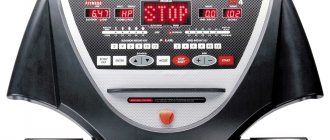Treadmill training programs[edit | edit code]
Treadmill
If you think that working out on a treadmill is limited to walking or jogging, you are sorely mistaken. Find out what variety of exercises and workouts this machine can give you.
There are many fitness methods for getting rid of extra pounds, but opinions agree on one thing: a treadmill for losing weight is the most effective means, of course, subject to a well-designed training program.
The benefits of a treadmill[edit | edit code]
Training on a treadmill has a healing effect on the entire body: your blood pressure is normalized, the functioning of the cardiovascular and respiratory systems improves, and bones are strengthened. This aerobic exercise, which is running, develops your endurance. You saturate the entire circulatory system with oxygen, increasing muscle tone. And all this in addition to the fat-burning effect. On average, calorie consumption on a treadmill is 600-700 kcal/hour. This number may vary depending on the intensity of your workout.
Researchers from King's College London have found that exercise that strengthens leg muscles can improve cognitive performance in older adults over the long term. In a study of 324 healthy twin sisters followed for 10 years, researchers found that leg exercise slowed the rate of brain aging, which was a protective factor against Alzheimer's disease. [1]
When not to run on a treadmill
Contraindications:
- Even if you feel well, you should not exercise in late pregnancy.
- People who have any diseases in the legs, joints and lower back should not run on the treadmill.
- People who have problems with blood pressure can exercise at a slow pace.
- People with varicose veins should not exercise.
- If during training a person feels overworked, the training must be stopped.
How to run properly[edit | edit code]
Treadmill training programs
Running technique. While doing exercises on the treadmill, your shoulders and chest should be straightened and your abs tense. The arms are also included in the work: they are bent at the elbows at a right angle and act in the opposite direction, which increases blood flow. Move smoothly, gradually increasing the pace from slow to fast. Read more:
running technique.
Breath.
Breathe deeply through your nose.
Best time to train.
The debate about whether it is healthier to run in the mornings or evenings has been raging for a long time. If you have time in the morning, start the day with a cold or contrast shower and a run on the treadmill. This will energize you for the long day and will rev up your metabolism to earn carbs for breakfast. An evening run will allow you to relieve stress and calm your mind, in addition to all the other effects of running. Whatever time you choose to exercise on the treadmill, it is definitely healthier than lying on the couch.
Heart rate zone for fat burning[edit | edit code]
To calculate the effective heart rate zone for an adult, during exercise in which the muscles work and the fat burning process occurs, a special formula is used:
“220 minus (number of years)” or “200 minus (years after 20 years)”
Once you've calculated your maximum heart rate for your age (if you're 40, it's 180 beats per minute), you can determine your effective zone. In this example, this is 65 - 85% of the maximum, that is, from 180x0.65 to 180x0.85 = 117-153. It is better for you not to cross the boundaries of this zone: if the pulse is higher, there is a risk of overload, if lower, the effect of training on the treadmill will be minimal. Remember your effective heart rate and try to stay within its limits during cardio. But be careful: If you're 40 and this is your first cardio workout since college football, choose a gentler regimen.
Duration of training[edit | edit code]
Due to the physiological characteristics of the body, it is important that your training is long enough. You can exercise with a heart rate slightly below the effective zone, but in this case your training on the treadmill should be longer by 20-30 minutes, ideally from 40 minutes to 1 hour. The optimal amount of training on a treadmill is 3 times a week. If you exercise more often, the body simply will not have time to recover and such loads will not bring benefits. And a weight loss program consisting of 1-2 workouts per week is practically useless (unless you supplement it with strength training).
Treadmill exercises[edit | edit code]
Walking
It has an almost miraculous effect. In addition to accelerating the fat burning process, walking can relieve tension while simultaneously working all muscles. A minimum of 30 minutes of vigorous walking a day, either outside or on a treadmill, will help you maintain cardiovascular and respiratory health.
Run
The benefits of running on a treadmill are literally legendary. This type of cardio is the most popular, and is truly addictive - in the good sense of the word. If the first runs may give you mixed feelings of reluctance and laziness, then over time running training will be a joy.
Sprint
Allows you to get the most out of your potential. This type of treadmill workout requires you to push yourself to the limit, but also burns calories at full capacity.
Inclined
This is the easiest way to make your workout more challenging. By changing the incline angle, you contribute to even faster weight loss during workouts on the treadmill. Today, a method based on alternating walking at an incline and walking at a certain speed is increasingly gaining popularity in the niche of cardio training. And for good reason: regular exercise of this type really allows you to get your figure into the desired shape in a short time.
Speed
The main enemy of training effectiveness is monotony. There is only one way to avoid tedious exercise - by turning your treadmill workout into a game of speed. By alternating between jogging and walking, or walking and running at top speed, you'll get more fun and better results from your treadmill workout.
Interval training on the treadmill
If you accept the rules of the speed game mentioned above and include alternating rest and acceleration in your workouts, you can lose weight many times faster. This type of training is called interval training, it is distinguished by the duration of the intervals: limited in time or lasting as long as you have the strength.
Clearly timed intervals in training on a treadmill can be different, for example, 1 minute of sprint, 2 minutes of recovery, or 4 minutes of intense running with an incline, rest - 7 minutes. Planning for such an interval cardio workout on a treadmill depends on your physical fitness and cardiovascular health.
Interval training on a treadmill that does not have clear intervals is called “fartlek”, from the Swedish fartlek - “speed game”. This type of training involves running at full strength until failure, to use bodybuilding terminology. Once your strength is gone, take a recovery break, walk, and then run again at top speed. The most important thing for weight loss in this type of training on the treadmill is to work at your limit during the speed segment. Give it your all, stopping only when you no longer have the strength.
Whichever treadmill interval training program you choose, you'll notice results soon: it's been proven that calories continue to be burned even after the workout ends. set of exercises on a treadmill
What speed should you be during training?
The treadmill belt moves at different speeds. Depending on this factor, the intensity of the workout changes. The higher the speed, the faster the person must perform the movement.
Rules for the training:
- You should start training at the lowest speed, more precisely, with easy walking. Once the muscles are warmed up, you can gradually increase the pace. Warm-up can last about 1 minute.
- After the muscles have warmed up, you need to do a light jog for three minutes. The canvas should be at an angle of 2 degrees. The speed should be increased by one notch.
- After a five-minute warm-up, you can move on to the main set of exercises, jogging or brisk walking, at the consumer’s request. The resistance angle should also be 2 degrees, while the speed should be increased as much as is comfortable. If the exercises are performed with the aim of improving health, then it is enough to stop at an average speed, if for weight loss, then at the maximum possible for the consumer. You should also monitor your pulse (you can do this using a special heart rate monitor); it should be within 130 beats per minute.
- In order to avoid pain in the joints, after the main workout, you should run for five minutes at the slowest pace until breathing is restored.
- After completing the workout, you need to walk at an easy pace.
Treadmill training[edit | edit code]
Select your level[edit | edit code]
For beginners
: You must be prepared to engage in aerobic training for at least 3 months. Spend at least 2-4 weeks on endurance training, and only then move on to interval training.
For those continuing
: You are in this group if you have been doing aerobic exercise at least 3 times a week for 3 months or more.
Advanced
: You can focus on the level of requirements for this group if you have been doing aerobic training 4-5 times a week for at least 6 months.
All workouts should begin with a warm-up - 5 minutes of low-intensity cardio exercises: leisurely jogging around the gym or exercises on cardio equipment. The same amount of time should be allocated to complete the workout for the cool down. Cardiac activity should be changed gradually, the most harmful thing for our heart is not only the rapid onset of intense long-term exercise, but also its abrupt cessation.
Choose an aerobic intensity level that allows you to maintain a steady heart rate throughout your workout.
The principle of training[edit | edit code]
Every two weeks for beginners and intermediates, you can either increase the intensity of your workout or increase your workout time by 5%.
Most importantly, do not increase the intensity and duration of your workout at the same time!
The proposed cardio training program on a treadmill is designed for 30 minutes and consists of a warm-up, a uniform load, buttock training and a tempo part.
Warm-up
- Duration - 5 minutes
- Running speed - 5-6.5 km/hour
- Slope - 0%
Start your workout at the lowest speed. After two minutes, increase the speed by 0.3 km/h every 30 seconds. Gradually increase your speed to 5.5 km/h.
From time to time you can rise on your toes, holding the handrails, then walk on your heels for a few seconds. This is necessary to prepare the lower leg for walking uphill.
Try to stretch your arms and upper torso as well.
Uniform load
- Duration - 10 minutes
- Speed - 6.5 km/h
- Slope - 1%
Gradually increase your speed by 0.3 km/h until you are running.
At this point, those who prefer walking should reduce their speed by 1 km/hour, and those who prefer running should increase their speed by 1 km/hour.
Drive at this operating speed for 5 minutes on a 1% incline.
Then increase the incline to 3%, and for 5 minutes, increase the incline by 1% every minute thereafter, up to a total of 8%.
Strengthening the buttocks
- Duration - 10 minutes
- Working speed
- Slope varies
- Reduce the slope to 2%. Walk or run at a working speed for 1-2 minutes. After this, walk or run at maximum speed, and then for 1 minute reduce the speed by 1-2 km/h.
Repeat the intervals twice. Increase the incline to 12% and begin brisk walking at a steady speed for 3-4 minutes. Repeat intervals and moving uphill.
Tempo part
- Duration - 5 minutes
- Speed - working
- Slope - 2%
- Reduce the incline to 2% and run or walk at your running speed for 4 minutes. Then reduce the incline to 0% and gradually slow down to lower your heart rate.
Don't forget a water bottle and a towel. Guide yourself - 50 ml every 10 minutes. Read more:
water during and after training.
Goal: make your legs beautiful
Choose between hills and rough terrain programs on the track. In “hills,” ascents alternate with movement in a straight line (this task is more difficult), and in “rough terrain,” with descents. If you are not very hardy yet, it is better to choose this one. But just don’t try to alternate walking uphill with running in a straight line. This is an unfortunate option: an experienced athlete rests while running in a straight line, but for beginners, both running and walking uphill is a considerable load. In this case, it is better to reserve only one of the running sessions per week for “hills”.
It is better to line up the “hills” as follows (by slope in percentage): 1-3-1-5-1-7-1-5-1-3-1. Run at your average pace, uphill for 1 minute, straight for 40 seconds. Don't forget about the cool-down and warm-up: 7-10 minutes of easy running at the beginning and end of the workout.
Goal: develop speed qualities
After 5-7 minutes of easy warm-up running, begin to accelerate. “To learn to develop higher speed, do a 25-second jerk, trying to give your best,” advises Evgeniy. - Then go to a slow run or vigorous walk and recover for 2-3 minutes. Make another throw, rest again. Repeat two times or more. How much exactly - decide based on your well-being (as soon as you realize that you are too tired for the jerk, stop) and time - interval training should not be longer than 20-30 minutes.”
To develop speed endurance (after all, our task is not just to rush to the finish line, but also to reach it), accelerate to a heart rate of 80-90% of the maximum and try to maintain the pace for 40-50 seconds. Then rest for 3-5 minutes.
Goal: lose weight by 5 kg
The figure in this case is very arbitrary: in three months you can lose one or eight kilos, depending on your initial weight (very obese people lose weight faster), nutrition and the amount of training. The treadmill offers two paths to a slim figure.
First
- long, 40-60 minutes, workouts at a moderate pace (heart rate - 60-70% of maximum). Light running or walking, which is more suitable for obese people, can be practiced at least daily or even twice a day. For the muscles, this is not such a serious load that a day of rest is required after it.
Second way
- interval training. The intervals here will be different than with speed training. Try starting with one-minute bursts of acceleration, alternating them with a three-minute rest - running at a moderate pace. The task can be gradually made more difficult by increasing speed intervals and reducing recovery time: first to a ratio of 1:1, then to 2:1. It's important not to overwork yourself. Since interval training can lead to overtraining, you need to alternate it with others and apply it: we give it our all for two or three weeks, then take a break.
Remember that diet is the main contributor to fat loss.
Increase the effectiveness of your exercise bike workout
Adjust your seat height before you start so that your leg can reach the pedal freely as you move down.
The thigh muscle is tense when the leg goes down and relaxed when it goes up.
If you want to build muscle, use high resistance; if you want to reduce weight, use medium resistance.
Intensity depends on speed:
- light 15 km/h;
- moderate 22-25 km/h;
- high up to 30 km/h.
What results can you achieve with cardio exercise?
The results of training largely depend on the intensity and weight of the athlete. A 1-mile moderate-intensity run can easily burn 100 calories. As your running speed increases, your metabolism and fat burning increases.
Calorie consumption largely depends on the weight of the athlete - the greater the body weight, the faster the extra pounds are lost. When doing cardio workouts to burn fat, it is important to monitor your running pace. This indicator is important both when training the cardiovascular system and when doing cardio exercises aimed at losing weight.












